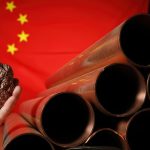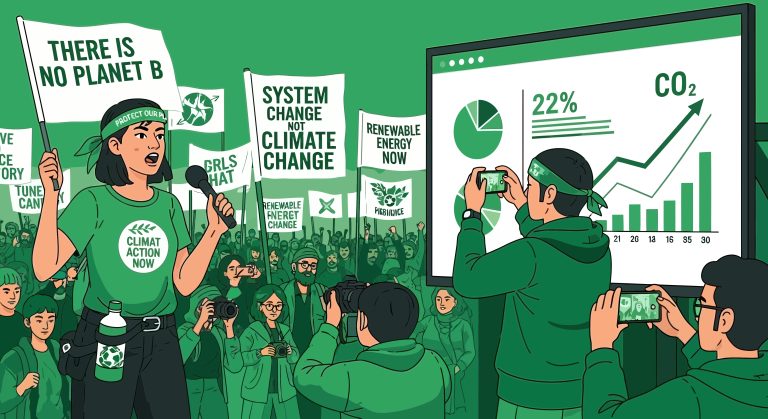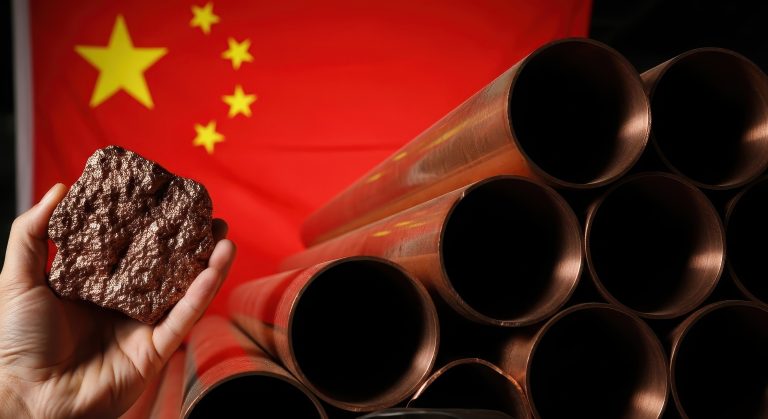
A stylized protest scene reflects the passionate face of global climate activism — and the backdrop of influence that may be quietly shaping it.
A NEW FRONT IN THE POWER STRUGGLE
What if the world’s most aggressive climate activism isn’t just a moral crusade — but also a tool of foreign power?
New evidence suggests that China, long the world’s largest polluter and the leading producer of “green” technologies, may be quietly supporting environmental activism in Western nations. The strategy: use Western environmentalists to stall Western industry.
By funding, influencing, or amplifying environmental protests — particularly those targeting energy, mining, and infrastructure projects — Beijing ensures that the West remains dependent on China for rare earth minerals, green technology, and critical supply chains.
It’s a subtle but devastating form of asymmetric warfare: let your rivals protest themselves into paralysis, while you profit from their restraint.
CHINA’S STRATEGY: WEAPONIZING IDEALISM
China’s leadership has long understood the power of resources. Deng Xiaoping once said, “The Middle East has oil; China has rare earths.” Today, that statement reads like prophecy.
Beijing controls:
- 70% of global rare earth mining,
- 90% of global processing, and
- the majority of global solar panel and EV battery manufacturing.
Western nations, meanwhile, are bound by their own environmental laws and political divisions — many fueled by increasingly radical climate movements.
The new theory, now being discussed in congressional hearings and intelligence circles, is that China is amplifying these movements — not to save the planet, but to stop the West from competing.
By covertly supporting campaigns that shut down mining, fracking, and industrial projects, China keeps control over the very materials the West needs to “go green.”
The effect: environmental groups do the heavy lifting of Chinese industrial policy — for free.
FOLLOWING THE MONEY: CHINESE FOUNDATIONS AND WESTERN NGOS
The most visible trail leads through an organization called Energy Foundation China — a San Francisco-based nonprofit with deep ties to the Chinese Communist Party.
Tax filings show it has funneled millions of dollars to U.S. climate groups, including:
- Natural Resources Defense Council (NRDC) – a key player in anti-pipeline litigation.
- Rocky Mountain Institute (RMI) – a think tank whose gas-stove study triggered national bans.
- World Resources Institute (WRI) – a global sustainability organization.
While these groups claim the funds are earmarked for “projects in China,” critics in Congress argue that the lines are blurred. Senator Ted Cruz called the network “an alliance between leftist billionaires, radical environmental organizations, and the CCP.”
In short: money flows from Beijing to Western NGOs that advocate for policies that — intentionally or not — cripple Western energy independence and reinforce China’s industrial monopoly.
DRAGONBRIDGE: WHEN CHINA WENT UNDERCOVER
In 2022, cybersecurity firm Mandiant exposed an online disinformation campaign called Dragonbridge — a covert Chinese operation that used fake social media accounts posing as American environmentalists.
Their mission: spark protests against rare-earth mining projects in Texas and Canada.
The fake “activists” spread misinformation about toxic waste, claimed to be local residents, and used repurposed photos from old protests in Malaysia — all to drum up public outrage and block U.S. supply chain projects that would compete with China.
The campaign was so extensive that the Pentagon confirmed its existence. It marked the first proven instance of Beijing impersonating Western climate activists to protect its resource dominance.
ACTIVISM, INFLUENCE, AND DARK MONEY
At the ground level, the pattern continues.
One of the newest and most aggressive protest movements in the U.S., Climate Defiance, receives more than half its funding from the Oil and Gas Action Network (OGAN) — which in turn, is backed by Energy Foundation China.
These groups aren’t alone. Investigations have traced Chinese-linked funding into a web of “green” nonprofits and think tanks pushing for oil bans, fracking moratoriums, and opposition to domestic mining — all while Beijing builds new coal plants at record speed.
The irony is staggering: China publicly champions climate action while secretly amplifying climate extremism abroad to handicap its competitors.
THE SINGHAM NETWORK: WHEN IDEOLOGY MEETS INFLUENCE
Another case under congressional review is Code Pink, an American activist group known for anti-war and climate justice protests.
After its co-founder married millionaire Neville Roy Singham — a self-proclaimed admirer of the CCP — the group began parroting Chinese propaganda and launched campaigns like “China Is Not Our Enemy.”
Financial records show that roughly a quarter of Code Pink’s funding now flows through Singham’s network of nonprofits and shell foundations linked to Chinese interests.
What looks like progressive activism may in fact be state-aligned messaging disguised as peace and environmentalism.
THE IMPACT: SUPPLY CHAINS, ENERGY, AND STRATEGIC DEPENDENCE
The effects of this strategy are visible across the Western world.
- Rare Earth Projects: U.S. and Australian mining efforts face endless “local” protests — some of which Chinese propaganda amplifies online.
- Oil and Gas: Activist campaigns have shut down U.S. pipelines and drilling, forcing reliance on imports (including Chinese solar panels and batteries).
- Nuclear Energy: Environmental lobbies helped push Europe away from nuclear power — even as China built over 50 new reactors.
- High-Tech Manufacturing: Environmental lawsuits delay semiconductor plants, while China dominates chip-related chemical production.
Each canceled project, each blocked permit, each delayed refinery keeps the West more dependent — and Beijing more powerful.
THE NED PARALLEL: A PLAYBOOK REVERSED
Beijing’s tactics mirror the National Endowment for Democracy (NED) — a U.S. government-backed nonprofit that funds pro-democracy movements abroad.
Chinese officials frequently accuse NED of fomenting “color revolutions” under noble pretenses. Now, China appears to be turning that model inside out — funding Western NGOs to achieve its own strategic revolutions in the name of climate.
Beijing’s climate diplomacy is not about reducing emissions. It’s about redirecting leverage.
CONCLUSION: GREEN IDEALS, RED HANDS
Western climate activism remains overwhelmingly genuine — driven by citizens who care deeply about the planet. But Beijing’s influence exploits that sincerity, bending moral conviction into geopolitical strategy.
By funding nonprofits, manipulating online discourse, and amplifying activist outrage, China has found a way to paralyze its rivals without confrontation.
As one defense analyst put it:
“Beijing doesn’t need to sabotage our industries — it just needs to fund the protests that stop us from building them.”
The result is a world where the loudest cries for “saving the planet” may also echo the quietest ambitions of China’s ruling elite.
The Green Trojan Horse is already inside the gates.








